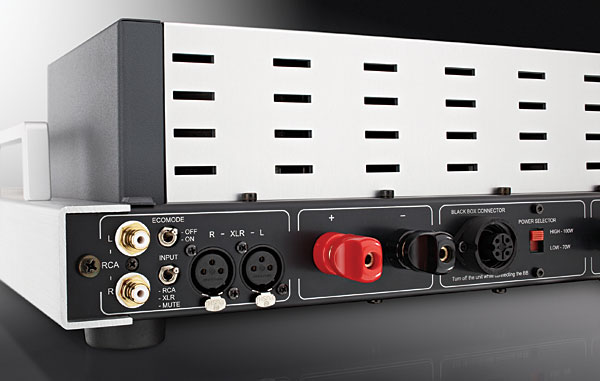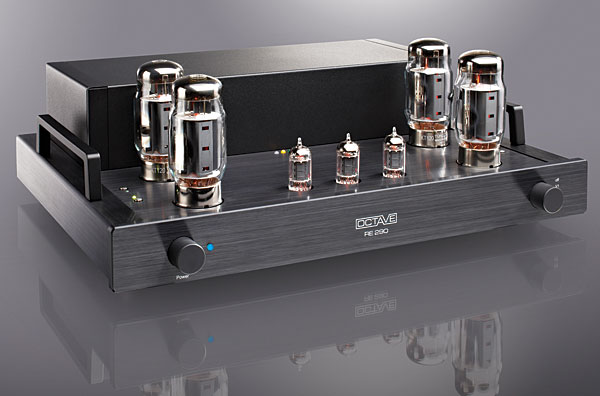| Columns Retired Columns & Blogs |
Octave Audio RE 290 power amplifier Page 2
The singers of the PSU Chamber Choir poured their souls into every take, and Steve and Ethan got some great singing out of them. During the mixing and mastering phases, I used the Octave RE 290 and my Revel Performa F30 speakers to make all of my final decisions. I found the RE 290 to be a very neutral tool as I tried to combine the various microphone arrays used on this album to produce an acceptable mix. With the Octave, I was able to clearly hear the separate qualities and positions of the pairs of Schoeps cardioid mikes (in an ORTF array) and the Schoeps omnidirectional mikes spaced about 8' apart, as well as a distant pair of omnis used to pick up the sound of the room. And what a room! The acoustic of St. Stephen's Catholic Church in Portland is luscious, to say the least—close to four seconds of decay. My task was to find a mix that kept enough of the presence of the choir while still maximizing the ensemble's blend. The Octave RE 290 opened a wonderfully clear window on the soundwork I was doing, and helped me make correct and efficacious decisions in mixing and equalization. The RE 290 was neither too euphonic nor too sterile, nor was its sound unbalanced in any way from top to bottom of the audioband.
The album's title track, Esenvalds's A Drop in the Ocean, offered coherent and full-bodied sound. The work is a setting of Mother Teresa's favorite prayers, and includes a statement of her own: "My work is nothing but a drop in the ocean, but if I did not put that drop, the ocean would be one drop the less." This performance has a huge dynamic range—from whispers and murmurs to bombastic yelling and soaring sopranos. The RE 290 was just able to reproduce this absurdly dynamic track at realistic levels. But if I pushed it too hard, the amp gently clipped. Some amps seem more powerful than their rated power, some less; the RE 290 sounded exactly like an amp that puts out 100Wpc into 4 ohms. If you play big orchestral, choral, or operatic music at loud volumes, you may need to partner the RE 290 with speakers of more-than-average sensitivity. Mind you, this music is about as punishing as it gets; the RE 290 did a great job of making the loud moments of Esenvalds's piece sound ecstatic instead of grating or hard. A Drop in the Ocean (CD, PDK-C-01) should be available from Amazon by the time you read this. Go get it!

As a foil to all that profound choral music, I rekindled my love for the early recordings of the B-52's. Through the RE 290 and Super Black Box, "Dance This Mess Around," from Nude on the Moon (CD, Rhino R2 78357), had oodles of punch and drive in the bass. Though this old recording has some grit and hash in the treble, the RE 290 and SBB did a nice job of revealing its flawed source without sounding too grainy or pinched. However, this track is also relatively uncompressed, and the RE 290 did a great job of allowing the space between the sounds to become—timbrally, temporally, spatially—part of the feel of this bluesy, Southern, dancey, new-wave punk—or whatever the B-52's were in 1979. The RE 290 had no trouble being the boss of this music, and was able to really rock the song out without compression or hardness. It had me doing "all 16 dances," per Fred Schneider's suggestion.
Modern recordings, such as Matmos and So Percussion's Treasure State (CD, Cantaloupe CA21065), were full of texture and nuance. "Needles," a work comprising sampled, electronically manipulated, and amplified cactus needles (I'm not making this up), has a dense mix with huge wallops of bass notes. The RE 290 did a remarkable job of controlling my woofers to produce nice, tight bass, sounding like a good solid-state amp as the rest of the mix plicked and plucked all over the soundstage. "Can't Run But," from Paul Simon's The Rhythm of the Saints (CD, Warner Bros. 26098-2), features percussion of a more traditional sort: The hypnotically layered marimbas and xylophones each held their percussive feel while offering warm, woody tones. The very neutral balance of the RE 290 gave the music an evenness that served this song well.
Missing Flight Recorder
I'd spent most of my time listening to the RE 290 with the Super Black Box because I wanted to give the SBB as much break-in time as possible. Now, to hear the effects of the Box, I did the opposite of my usual procedure: Instead of adding it to my system, I removed it.
Removing the SBB did a number of things to the RE 290's sound: The soundstage separation shrank, the bass became a little fuller but much looser, and the top octaves grew slightly more silky and liquid. The SBB opened up the soundstage in width and depth, added greater control to the lowest octaves, and, while extending the treble, also contributed to the highs a tiny bit of grain. The PSU Chamber Choir recording was a little less large and spacious without the SBB, but the singers' sibilants also sounded a bit more natural without it. The bass in "Dance This Mess Around" lost some drive sans SBB, but this track's slightly grainy treble was also a little easier on the ears, if not as extended. I heard the same thing with Matmos and So Percussion.
Overall, I slightly preferred the RE 290's sound with the Super Black Box, but I think each user would want to decide this for him- or herself. Much would depend on the sorts of speakers you use, what sort of music you prefer, and how willing you might be to add a tiny bit of grain (which I didn't notice until I took it away again) for the extra drive and soundstage breathing room offered by the SBB. What I can say is that I love that the Black Box and Super Black Box are options for the RE 290, and that they can be used in the same way you might use certain tubes—balancing tradeoffs in performance with your taste, system, and budget. Would the slight grain I heard have gone away after 1000 hours of listening? I don't know. Reviewers don't have that kind of time to spend with a product. What I heard was that the Super Black Box pulled from the tubed RE 290 a little bit more solid-state performance in terms of control and drive, while losing a bit of magical tube sound in the top octaves.
Versus a Reference
After spending time with the Octave RE 290 and Super Black Box, I returned to Audio Research's Reference 150, which, in many ways, is the best power amplifier I've heard. Only $505 separates the all-German Octave RE 290 with SBB ($13,500) from the all-American Reference 150 ($12,995). It looked like a fair fight.

For me, the hallmarks of ARC's Ref150 are its soundstaging, absolutely natural and extended tonal balance, an almost complete lack of electromechanical artifacts, and sufficient drive, guts, and balls for a tube amp. Listening again to the Ref150, I was reminded of why my respect for this amp has turned into something like love. While the Octave sounded open and neutral, full of tonal color, and offered a clear window on the recording, the ARC does all of that just a little bit better. The Ref150's soundstaging is significantly better than the Octave's, but the ARC is also significantly better at that than almost every other amp I've heard. The ARC opens a huge window on recordings. Not only is the soundstage large, the instruments themselves seem much bigger—much more like they sound in real life. And the Ref150 does all of this bigness without ever sounding bloated or euphonic. The Octave RE 290 is a very good amp, but the Audio Research Reference 150 has an ineffable quality of magic.
The Octave RE 290 was better than the Audio Research Ref150 amp in two areas. First, with the Super Black Box, the Octave had far tighter, more controlled bass than the Ref150. If you like what tubes do but are always jonesin' for a good solid-state amp's bass control, speed, rhythm, and clarity, then the RE 290 with SBB may be for you. Second, the physical beauty of the RE 290 makes the Ref150 look like a piece of lab equipment. Both are handmade, and it's clear that much care and love has been put into each. But if you believe, as I do, that how we physically live with an audio component is also important, then the Octave RE 290, in addition to its beautiful sound, will beautify your life, reminding you of the amazing things that people can make.
Conclusions
I loved my time with Octave Audio's RE 290. Thanks, JA, for picking a good one for me to review. It was fun to get to know a new (to me) company that truly cares about making beautiful-sounding, beautifully functioning, beautiful-looking audio gear. Recommended!
- Log in or register to post comments



































